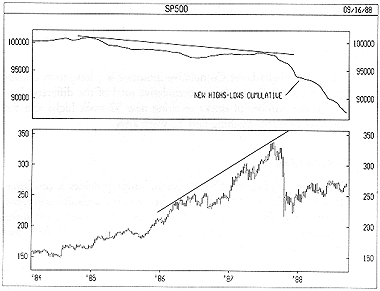
Technical Analysis from A to Z
by Steven B. Achelis
NEW HIGHS-LOWS CUMULATIVE
Overview
The New Highs-Lows Cumulative indicator is a long-term market momentum indicator. It is a cumulative total of the difference between the number of stocks reaching new 52-week highs and the number of stocks reaching new 52-week lows.
Interpretation
The New High-Low Cumulative indicator provides a confirmation of the current trend. Most of the time, the indicator will move in the same direction as major market indicies. However, when the indicator and market move in opposite directions, it is likely that the market will reverse.
The interpretation of the New Highs-Lows Cumulative indicator is similar to the Advance/Decline Line in that divergences occur when the indicator fails to confirm the market index's high or low. Divergences during an up-trending market indicate potential weakness, while divergences in a down-trending market indicate potential strength.
Example
The following chart shows the S&P 500 and the New Highs-Lows Cumulative indicator.

A classic divergence occurred during 1985 and 1986 where the S&P 500 Index was making new highs, but the New Highs-Lows Cumulative indicator was failing to surpass its previous highs. This was followed by the crash of 1987.
Calculation
The New Highs-Lows Cumulative indicator is simply a cumulative total of the number of stocks making new 52-week highs minus the number of stocks making new 52-week lows.
![]()
Contents
- Preface
- Acknowledgments
- Terminology
- To Learn More
- Bibliography
- About the Author
- Technical Analysis
- Price Fields
- Charts
- Support & Resistance
- Trends
- Moving Averages
- Indicators
- Market Indicators
- Line Studies
- Periodicity
- The Time Element
- Conclusion
- Absolute Breadth Index
- Accumulation/Distribution
- Accumulation Swing Index
- Advance/Decline Line
- Advance/Decline Ratio
- Advancing-Declining Issues
- Advancing, Declining, Unchanged Volume
- Andrews' Pitchfork
- Arms Index
- Average True Range
- Bollinger Bands
- Breadth Thrust
- Bull/Bear Ratio
- Candlesticks - Japanese
- CANSLIM
- Chaikin Oscillator
- Commodity Channel Index
- Commodity Selection Index
- Correlation Analysis
- Cumulative Volume Index
- Cycles
- Demand Index
- Detrended Price Oscillator
- Directional Movement
- Dow Theory
- Ease of Movement
- Efficient Market Theory
- Elliott Wave Theory
- Envelopes (Trading Bands)
- Equivolume/Candlevolume
- Fibonacci Studies
- Four Percent Model
- Fourier Transform
- Fundamental Analysis
- Gann Angles
- Herrick Payoff Index
- Interest Rates
- Kagi
- Large Block Ratio
- Linear Regression Lines
- MACD
- Mass Index
- McClellan Oscillator
- McClellan Summation Index
- Median Price
- Member Short Ratio
- Momentum
- Money Flow Index
- Moving Averages
- Negative Volume Index
- New Highs-Lows Cumulative
- New Highs-New Lows
- New Highs/Lows Ratio
- Odd Lot Balance Index
- Odd Lot Purchases/Sales
- Odd Lot Short Ratio
- On Balance Volume
- Open Interest
- Open-10 TRIN
- Option Analysis
- Overbought/Oversold
- Parabolic SAR
- Patterns
- Percent Retracement
- Performance
- Point & Figure
- Positive Volume Index
- Price and Volume Trend
- Price Oscillator
- Price Rate-of-Change
- Public Short Ratio
- Puts/Calls Ratio
- Quadrant Lines
- Relative Strength, Comparative
- Relative Strength Index
- Renko
- Speed Resistance Lines
- Spreads
- Standard Deviation
- STIX
- Stochastic Oscillator
- Swing Index
- Three Line Break
- Time Series Forcast
- Tirone Levels
- Total Short Ratio
- Trade Volume Index
- Trendlines
- TRIX
- Typical Price
- Ultimate Oscillator
- Upside/Downside Ratio
- Upside/Downside Volume
- Vertical Horizonal Filter
- Volatility, Chaikin's
- Volume
- Volume Oscillator
- Volume Rate-of-Change
- Weighted Close
- Williams' Accumulation/Distribution
- Williams' %R
- Zig Zag